Weighting Failure Mechanisms of Pre-Driven Recovery Rooms and Evaluation of Hydraulic Fracturing Applications: A Case Study
Abstract
:1. Introduction
2. Study Site
2.1. Geological Conditions
2.2. Support of the Main PRR
2.3. Potential Hazards
2.4. Roof Structure
3. Numerical Simulation
3.1. UDEC Trigon Model
3.2. Model Establishment
3.3. Parameter Calibration
3.4. Modeling Scheme
- (1)
- Firstly, the model was run to equilibrium after applying the boundary conditions. Rock bolts, anchor cables and chock supports were installed after the excavation of the PRR. In the model, structural “Cable” elements were generated to create the rock bolts and cables, structural “Beam” elements were generated to create the steel ladder beams, and the chock supports were represented by “Support” elements. The parameters of the support system in this paper are shown in Table 5.
- (2)
- Then, the 31108 panel was excavated. To achieve a thorough understanding of the influence of the mining activities on the coal body deformation of the inby fender in the PRR, a function was defined to monitor the triangular block zone vertical stresses and the break contact length of the inby fender via the UDEC embedded programming language FISH.
- (3)
- Finally, the inby fender was extracted. When the coal extraction was completed, the variation of triangular block zone horizontal stresses and the proportion of the broken contacts in the roof of the PRR were analyzed.
4. Analysis of Modeling Results
4.1. Deformation of the Inby Fender
- (1)
- When the break line is above the inby fender, a large area of vertical stress concentration generates in the coal body (Figure 8b,c). According to the statistical results, this area accounts for more than 40% of the fender area, as shown in Figure 9b. However, when the break lines are located above the PRR and the gob (Figure 8a,d), the loads exerted on the coal fender by the fractured blocks decrease significantly.
- (2)
- The crack statistics in the coal fender show that there is a small difference in the length of shear cracks under the four conditions, while the length of shear cracks is significantly longer than that of tensile cracks, as illustrated in Figure 9a. The tensile cracks are mainly distributed in the shallow part of the coal pillar. Crack propagation and coalescence result in pillar rib spalling.
- (3)
- Although there is little difference in the accumulated length of cracks in the four cases, a greater difference exists in the crushing degree at the pillar walls. This is related to the stress concentration degree in the coal fender. As can be seen in Figure 9b, the curves demonstrate that there is a positive correlation between the stress concentration area and the deformation amount at the pillar walls.
- (4)
- The modeling outcomes indicate that inappropriate estimation of the last weighting position may worsen the coal wall spalling at the longwall face, which is in good agreement with field observations.
4.2. Deformation of the PRR
4.3. Roof Cracks and Stresses
5. Hydraulic Fracturing
5.1. Borehole Layout
5.2. Effect of Hydraulic Fracturing
- (1)
- When the unmined panel was about 3 m, the stress on the roof cables increased sharply, as shown in Figure 14. At this time, the inby fender started to break and gradually lost its bearing ability. As the roof and floor strata coalesced in the gob, the stress on the roof cables gradually became stable within one day after the entrance of the longwall face to the PRR. The values of the force on the two measuring points were increased by about 50 kN and 133 kN, respectively. The force on the rib cables fluctuated slightly, and the increased value was no more than 10 kN. After hydraulic fracturing, although the stress on the roof cables increased with the transference of the abutment force, the roof remained stable without breaking down and the pillar ribs maintained good stability and bearing capacity.
- (2)
- The observation results of the four sets of separation instruments found that the separation amount of the roof within 2 to 12 m of the PRR was 0.67 mm, 0.05 mm, 0 mm and 0 mm, respectively. Hydraulic fracturing eliminated the risk of separation and dislocation of the roof strata in the process of mining-induced stress transference.
- (3)
- Figure 15 presents the cloud diagrams of the resistances of the panel supports. At 1:00 a.m. on 1 December 2021, when the PRR and 31108 longwall face were separated by about 30 m, a periodic weighting occurred in the main roof. The stresses on the 30# to 70# supports increased first, and the stresses on the 80# to 120# supports increased later. The weighting step was about 4 m. The average stress on the supports in the weighting area was about 44 MPa. After the longwall face entered the hydraulic fracturing area, extensive stress concentration on the supports did not appear because the gob roof collapsed in time. At 13:00 p.m. on 3 December, when the PRR and 31108 longwall face were separated by about 7–8 m, the stresses on the 23# to 80# supports increased slightly. Compared with the former weighting, the magnitude was smaller and the duration was shorter. In the face stop period (from 0 a.m. on the 4th to 0 a.m. on the 5th), the average stress on the supports was about 31.2 MPa, about 6 MPa higher than the initial stress. During extraction of the last 5-m-wide fender, high stresses on the supports did not appear.
- (4)
- In the process of withdrawing the equipment, the maximum shrinkage length of the hydraulic supports at the longwall face was 10 cm, and the maximum descending length of the chock supports in the PRR was 6 cm. Good roof stability reduced the difficulty of removing the equipment. Serious damage to the floor was not observed on site. The removal time was reduced by 3 days. Figure 16 is a field photo after hydraulic fracturing.
6. Conclusions
Author Contributions
Funding
Data Availability Statement
Conflicts of Interest
References
- Tadolini, S.C.; Barczak, T.M. Design parameters of roof support systems for pre-driven longwall recovery rooms. Trans. Soc. Min. Metall. Explor. 2004, 1–13. Available online: https://www.cdc.gov/niosh/mining/works/coversheet939.html (accessed on 17 April 2023).
- Kang, H.P.; Lv, H.W.; Zhang, X.; Gao, F.Q.; Wu, Z.G.; Wang, Z.C. Evaluation of the ground response of a pre-driven longwall recovery room supported by concrete cribs. Rock Mech. Rock Eng. 2016, 49, 1025–1040. [Google Scholar] [CrossRef]
- Oyler, D.; Frith, R.; Dolinar, D.; Mark, C. International experience with longwall mining into pre-driven rooms. In Proceedings of the 17th International Conference on Ground Control in Mining, Morgantown, WV, USA, 4–6 August 1998; pp. 44–53. [Google Scholar]
- Wang, X.Z.; Ju, J.F.; Xu, J.L. Theory and applicable of yield mining at ending stage of fully-mechanized face in shallow seam at shendong mine area. J. Min. Saf. Eng. 2012, 29, 151–156. [Google Scholar]
- Wang, B.N.; Dang, F.N.; Chao, W.; Miao, Y.P.; Li, J.; Chen, F. Surrounding rock deformation and stress evolution in pre-driven longwall recovery rooms at the end of mining stage. Int. J. Coal Sci. Technol. 2019, 6, 536–546. [Google Scholar] [CrossRef]
- Wang, F.T.; Shao, D.L.; Niu, T.C.; Dou, F.J. Progressive loading characteristics and accumulated damage mechanisms of shallow-buried coal pillars in withdrawal roadways with high-strength mining effect. Chin. J. Rock Mech. Eng. 2022, 41, 1148–1159. [Google Scholar]
- Barczak, T.M.; Tadolini, S.C.; Zhang, P. Evaluation of support and ground response as longwall face advances into and widens pre-driven recovery room. In Proceedings of the 26th International Conference on Ground Control in Mining, Morgantown, WV, USA, 31 July–2 August 2007; pp. 160–172. [Google Scholar]
- Tadolini, S.C.; Barczak, T.M. Rock mass behavior and support response in a longwall panel pre-driven recovery room. In Proceedings of the 6th International Symposium on Ground Support in Mining and Civil Engineering Construction, Cape Town, South Africa, 30 March–3 April 2008; pp. 167–182. [Google Scholar]
- Aghababaei, S.; Saeedi, G.; Jalalifar, H. Risk analysis of roof fall and prediction of damaged regions at retreat longwall coal mining face. Rud. -Geološko-Naft. Zb. 2020, 35, 85–95. [Google Scholar] [CrossRef]
- Wang, J.C.; Wang, Z.H.; Tang, Y.S.; Li, M.; Chang, K.L.; Gong, H.; Xu, G.L. Experimental study on mining-induced dynamic impact effect of main roofs in deeply buried thick coal seams with weakly consolidated thin bed rock. Chin. J. Rock Mech. Eng. 2021, 40, 2377–2391. [Google Scholar]
- Wang, G.F.; Pang, Y.H. Relationship between hydraulic support and surrounding rock coupling and its application. J. China Coal Soc. 2015, 40, 30–34. [Google Scholar]
- Mills, K.W.; Jeffrey, R.G.; Jones, D.W. Successful application of hydraulic fracturing to control windblast hazard at Moonee Colliery. In Proceedings of the 19th International Conference on Ground Control in Mining, Morgantown, WV, USA, 8–10 August 2000; pp. 45–50. [Google Scholar]
- Shimada, H.; Mastui, K.; Anwar, H. Control of hard-to-collapse massive roofs in longwall faces using a hydraulic fracturing techniques. In Proceedings of the 17th International Conference on Ground Control in Mining, Morgantown, WV, USA, 4–6 August 1998; pp. 79–87. [Google Scholar]
- Wang, X.Z.; Xu, J.L.; Zhu, W.B.; Ju, J.F. Influence of high mining speed on periodic weighting during fully-mechanized mining in a shallow seam. J. China Univ. Min. Technol. 2012, 41, 349–354. [Google Scholar]
- Itasca Consulting Group Inc. UDEC (Universal Distinct Element Code), Version 6.0; Itasca: Minneapolis, MN, USA, 2014. [Google Scholar]
- Gao, F.Q.; Stead, D. The application of a modified Voronoi logic to brittle fracture modelling at the laboratory and field scale. Int. J. Rock Mech. Min. Sci. 2014, 68, 1–14. [Google Scholar] [CrossRef]
- Kazerani, T.; Zhao, J. Micromechanical parameters in bonded particle method for modelling of brittle material failure. Int. J. Numer. Anal. Methods Geomech. 2014, 34, 1877–1895. [Google Scholar] [CrossRef]
- Lisjak, A.; Grasselli, G. A review of discrete modeling techniques for fracturing processes in discontinuous rock masses. J. Rock Mech. Geotech. Eng. 2014, 6, 301–314. [Google Scholar] [CrossRef]
- Kang, H.P.; Si, L.P.; Zhang, X. Characteristics of underground in-situ stress distribution in shallow coal mines and its applications. J. China Coal Soc. 2016, 41, 1332–1340. [Google Scholar]
- Gao, F.Q.; Stead, D.; Kang, H.P. Numerical simulation of squeezing failure in a coal mine roadway due to mining-induced stresses. Rock Mech. Rock Eng. 2015, 48, 1635–1645. [Google Scholar] [CrossRef]
- Singh, M.; Seshagiri Rao, K. Empirical methods to estimate the strength of jointed rock masses. Eng. Geol. 2005, 77, 127–137. [Google Scholar] [CrossRef]
- Cho, N.; Martin, C.D.; Sego, D.C. A clumped particle model for rock. Int. J. Rock Mech. Min. Sci. 2007, 44, 997–1010. [Google Scholar] [CrossRef]
- Konicek, P.; Saharan, M.R.; Mitri, H. Destress blasting in coal mining-state-of-the-art review. Procedia Eng. 2011, 26, 179–194. [Google Scholar] [CrossRef]
- Fan, J.; Dou, L.M.; He, H.; Du, T.T.; Zhang, S.B.; Gui, B.; Sun, X.L. Directional hydraulic fracturing to control hard-roof rockburst in coal mines. Int. J. Min. Sci. Technol. 2012, 22, 177–181. [Google Scholar] [CrossRef]
- Jeffrey, R.G.; Chen, Z.; Mills, K.W.; Pegg, S. Monitoring and measuring hydraulic fracturing growth during preconditioning of a roof rock over a coal longwall panel. In Proceedings of the ISRM International Conference for Effective and Sustainable Hydraulic Fracturing, Brisbane, QLD, Australia, 20–22 May 2013; pp. 894–914. [Google Scholar]
- Kang, H.P.; Jiang, P.F.; Feng, Y.J.; Gao, F.Q.; Zhang, Z.; Liu, X.G. Application of large-scale hydraulic fracturing for reducing mining-induced stress and microseismic events: A comprehensive case study. Rock Mech. Rock Eng. 2023, 56, 1399–1413. [Google Scholar] [CrossRef]
- Zhao, K.K. Three-Dimensional Propagation of Hydraulic Fracture from Regional Fracturing in Hard Roof. Ph.D. Thesis, China Coal Research Institute, Beijing, China, 2021. [Google Scholar]
- Guo, D.Y.; Lv, P.F.; Zhao, J.C.; Zhang, C. Research progress on permeability improvement mechanisms and technologies of coalbed deep-hole cumulative blasting. Int. J. Coal Sci. Technol. 2020, 7, 329–336. [Google Scholar] [CrossRef]
- Huang, B.X.; Wang, Y.Z.; Cao, S.G. Cavability control by hydraulic fracturing for top coal caving in hard thick coal seams. Int. J. Rock Mech. Min. Sci. 2015, 74, 45–57. [Google Scholar] [CrossRef]
- Kang, H.P.; Jiang, P.F.; Wu, Y.Z.; Gao, F.Q. A combined “ground support-rock modification-destressing” strategy for 1000-m deep roadways in extreme squeezing ground condition. Int. J. Rock Mech. Min. Sci. 2021, 142, 104746. [Google Scholar] [CrossRef]
- Yu, B.; Gao, R.; Kuang, T.J.; Huo, B.J.; Meng, X.B. Engineering study on fracturing high-level hard rock strata by ground hydraulic action. Tunn. Undergr. Space Tech. 2019, 86, 156–164. [Google Scholar] [CrossRef]


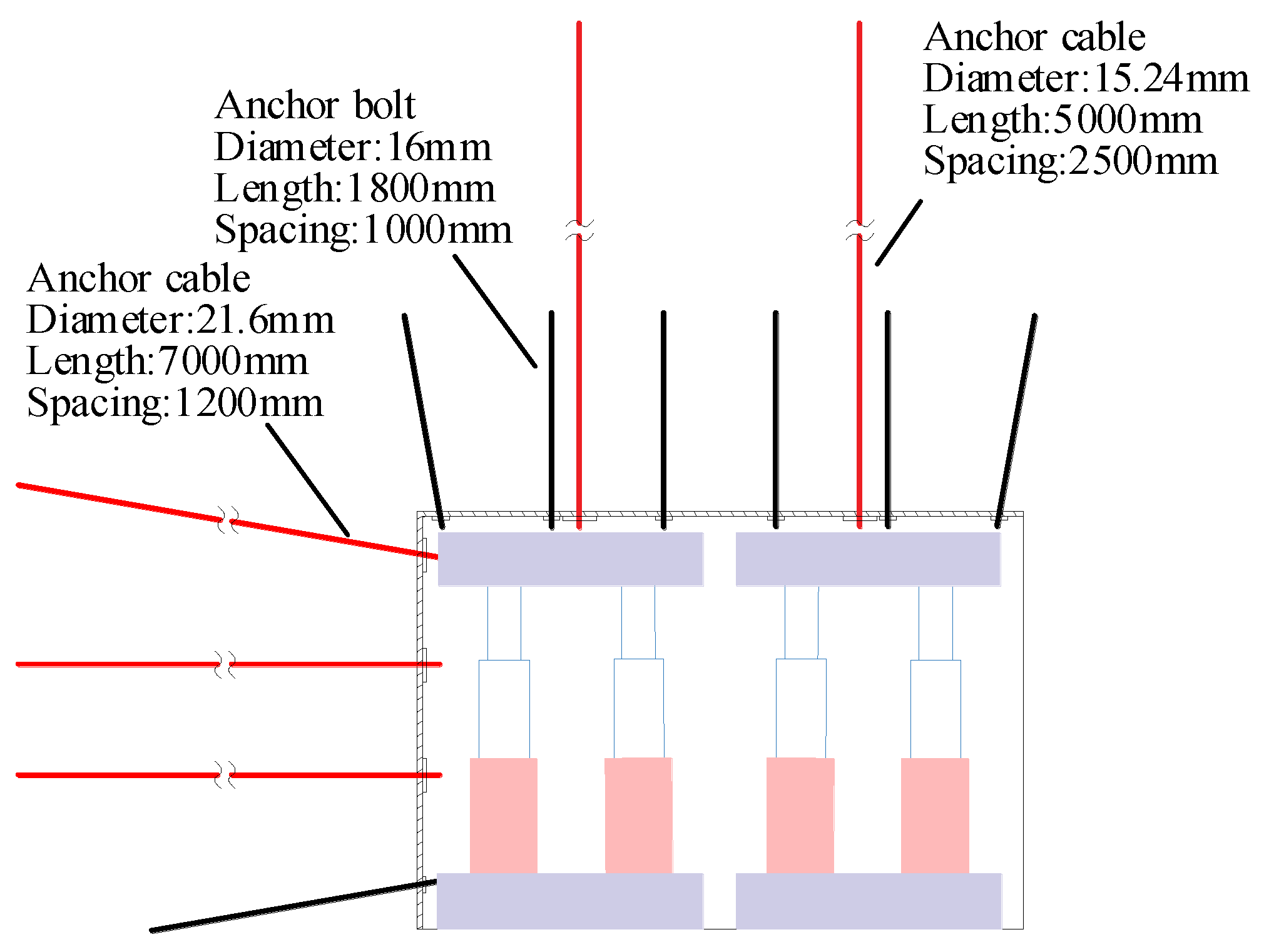
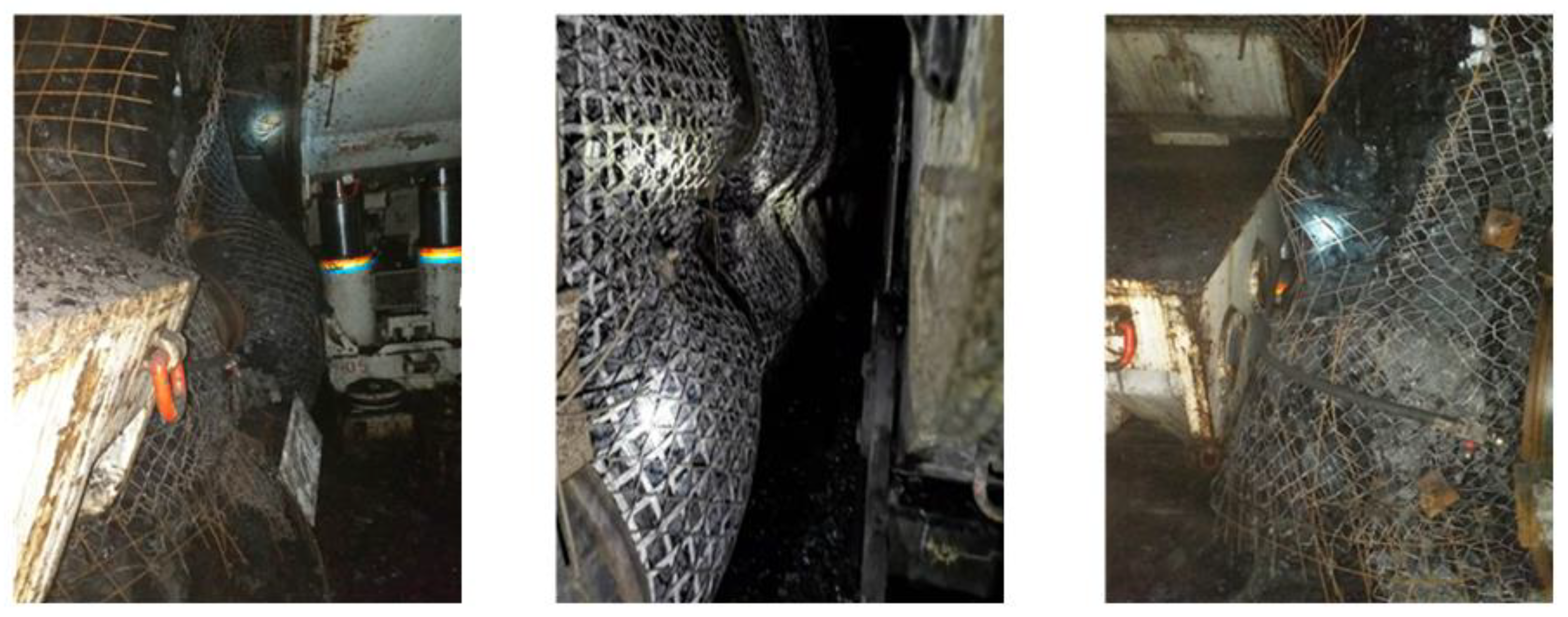


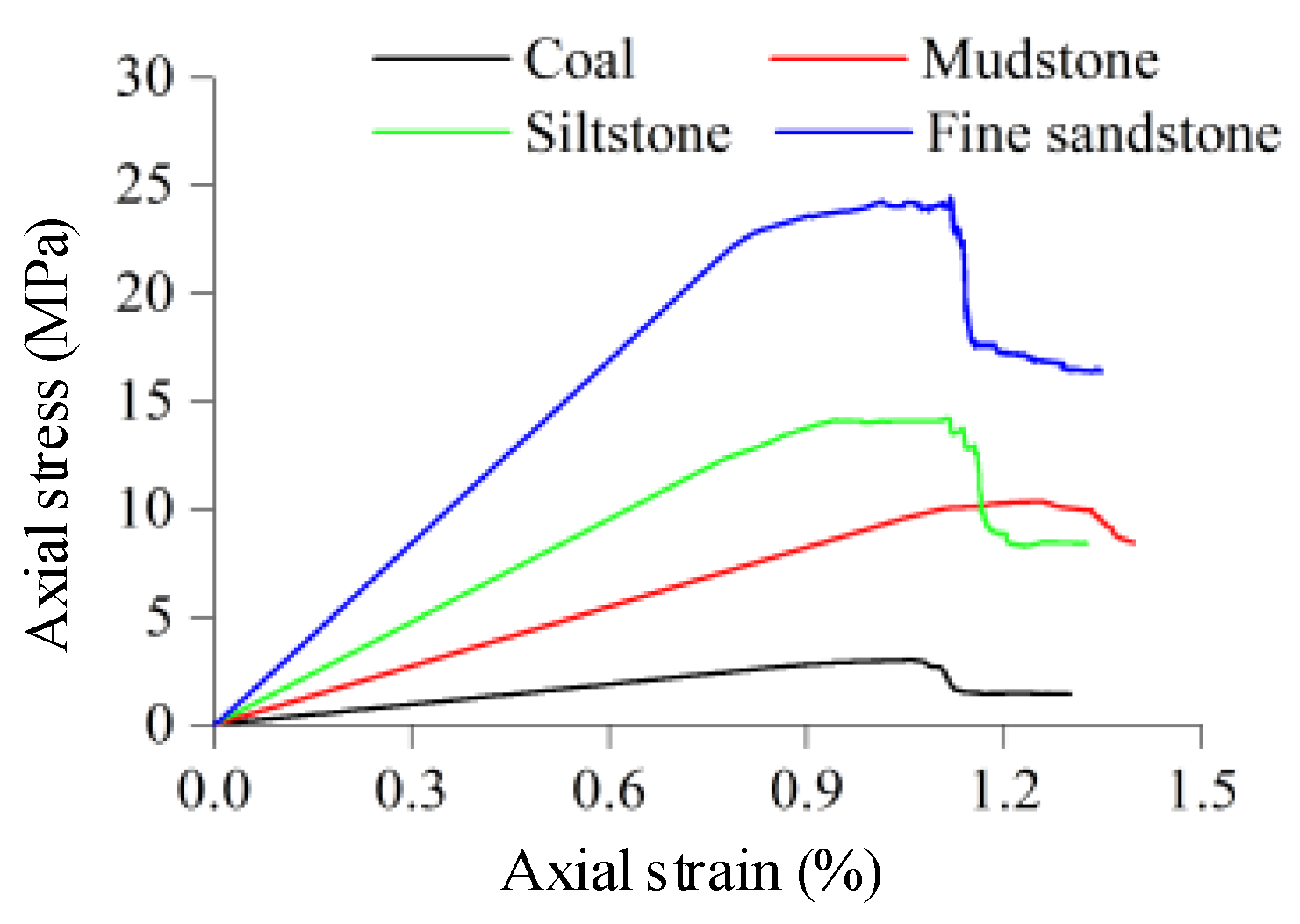
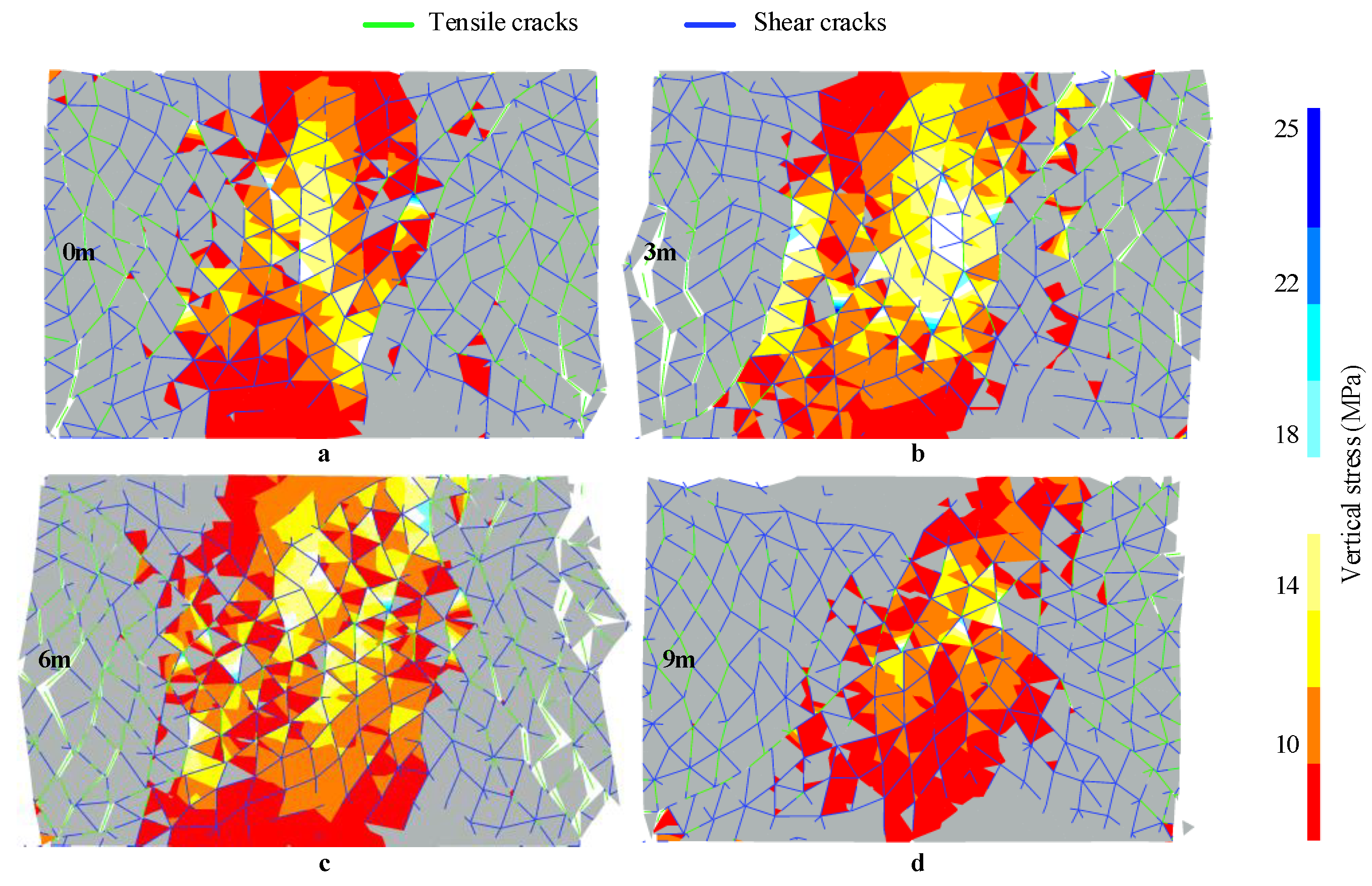

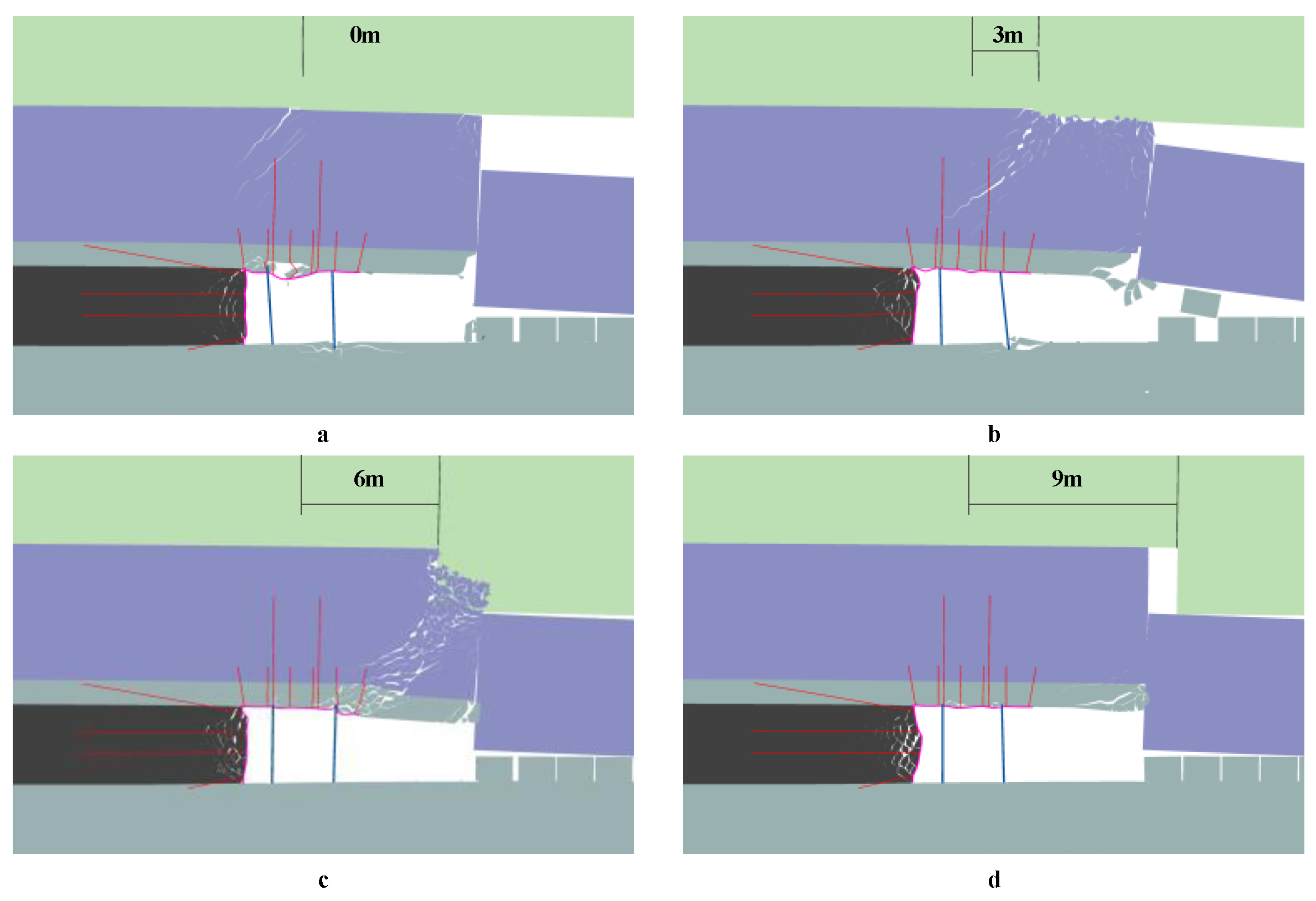
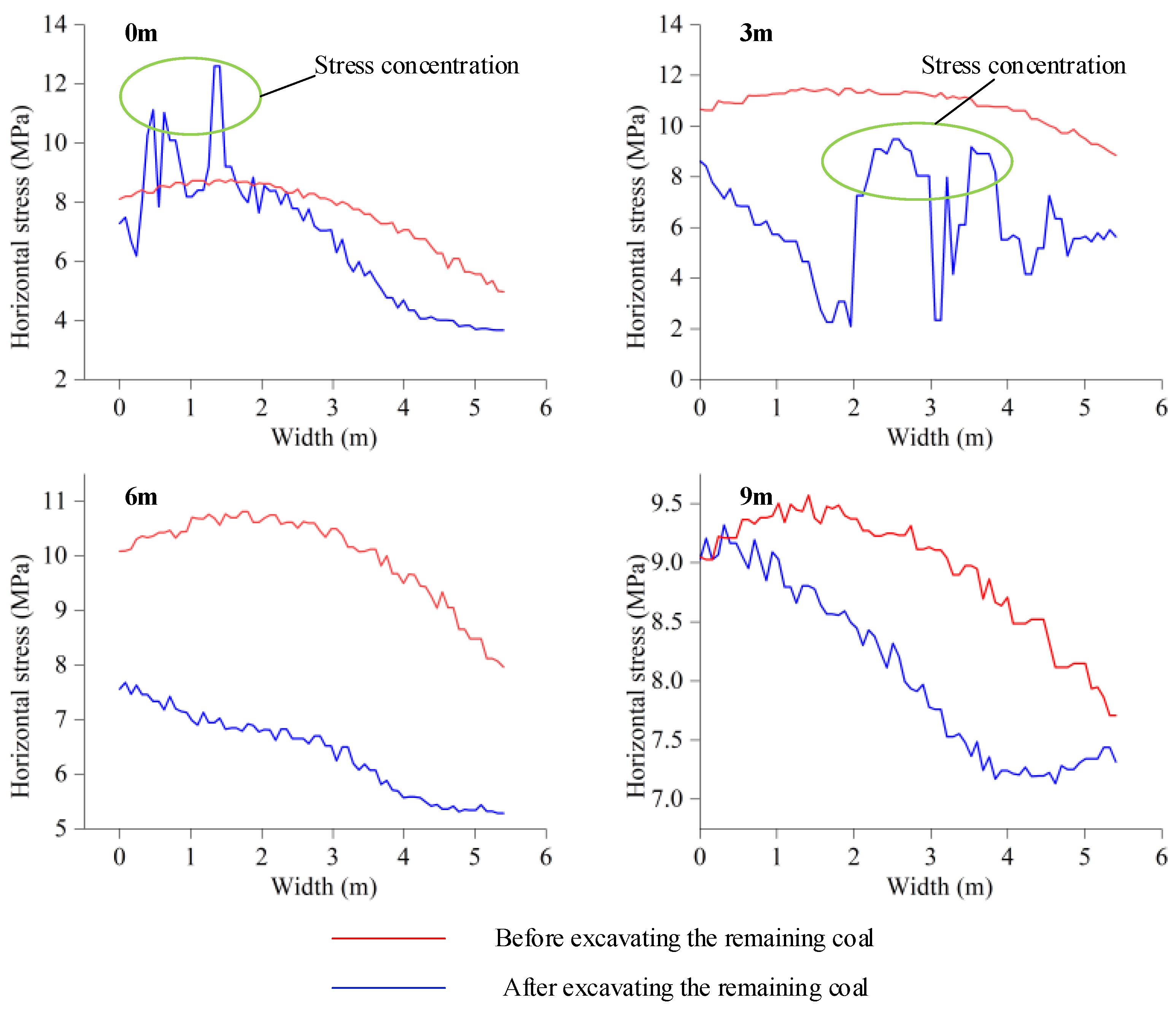
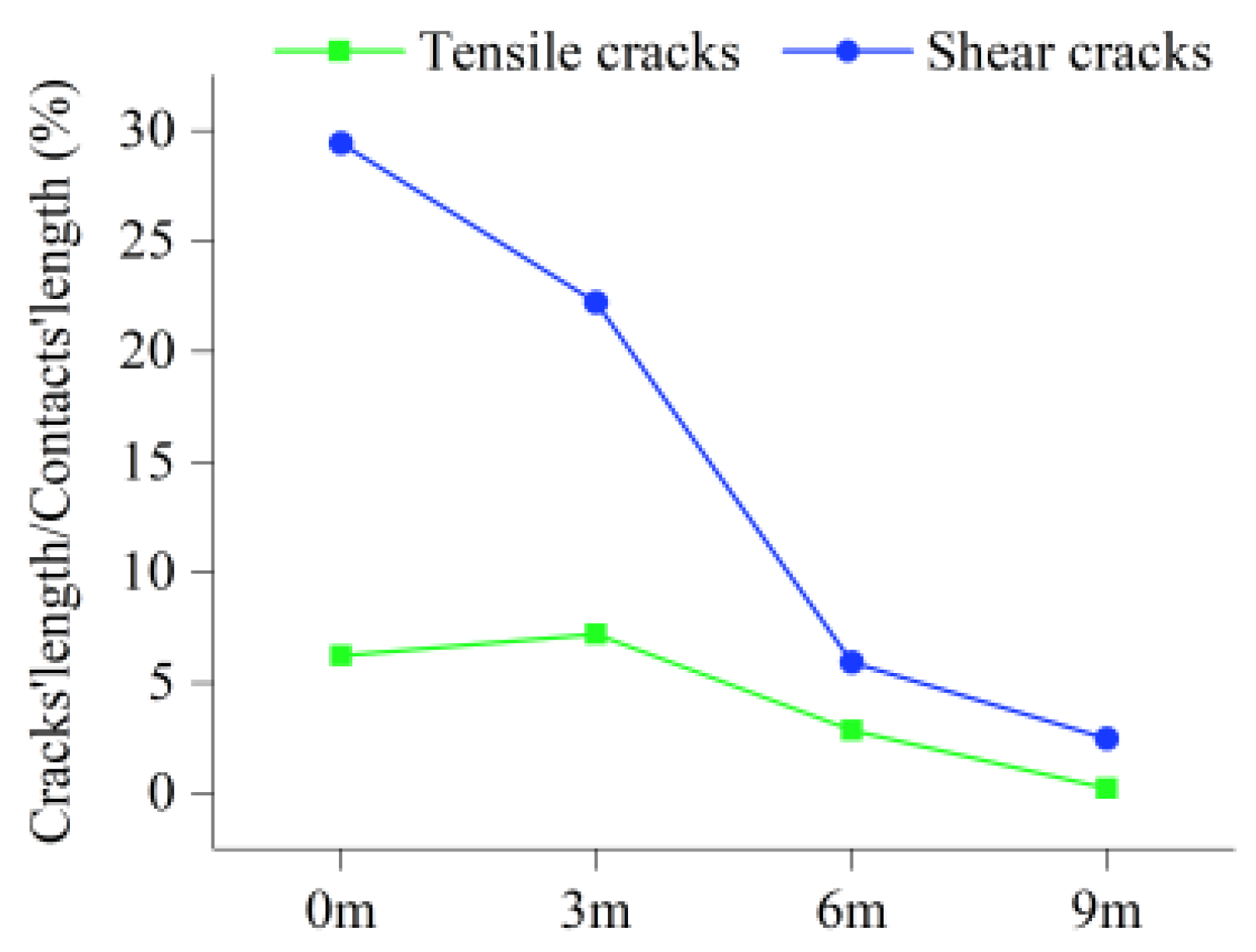

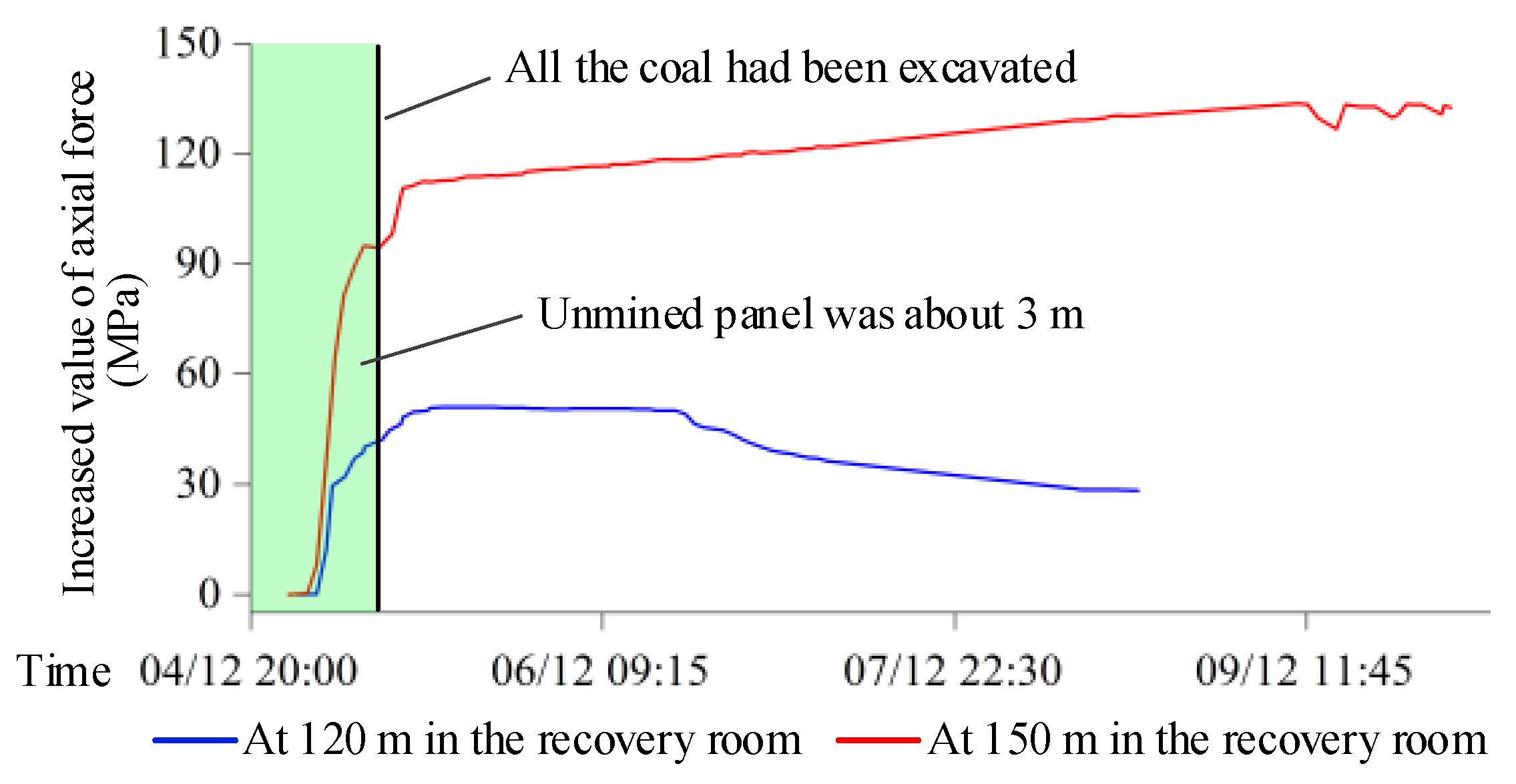
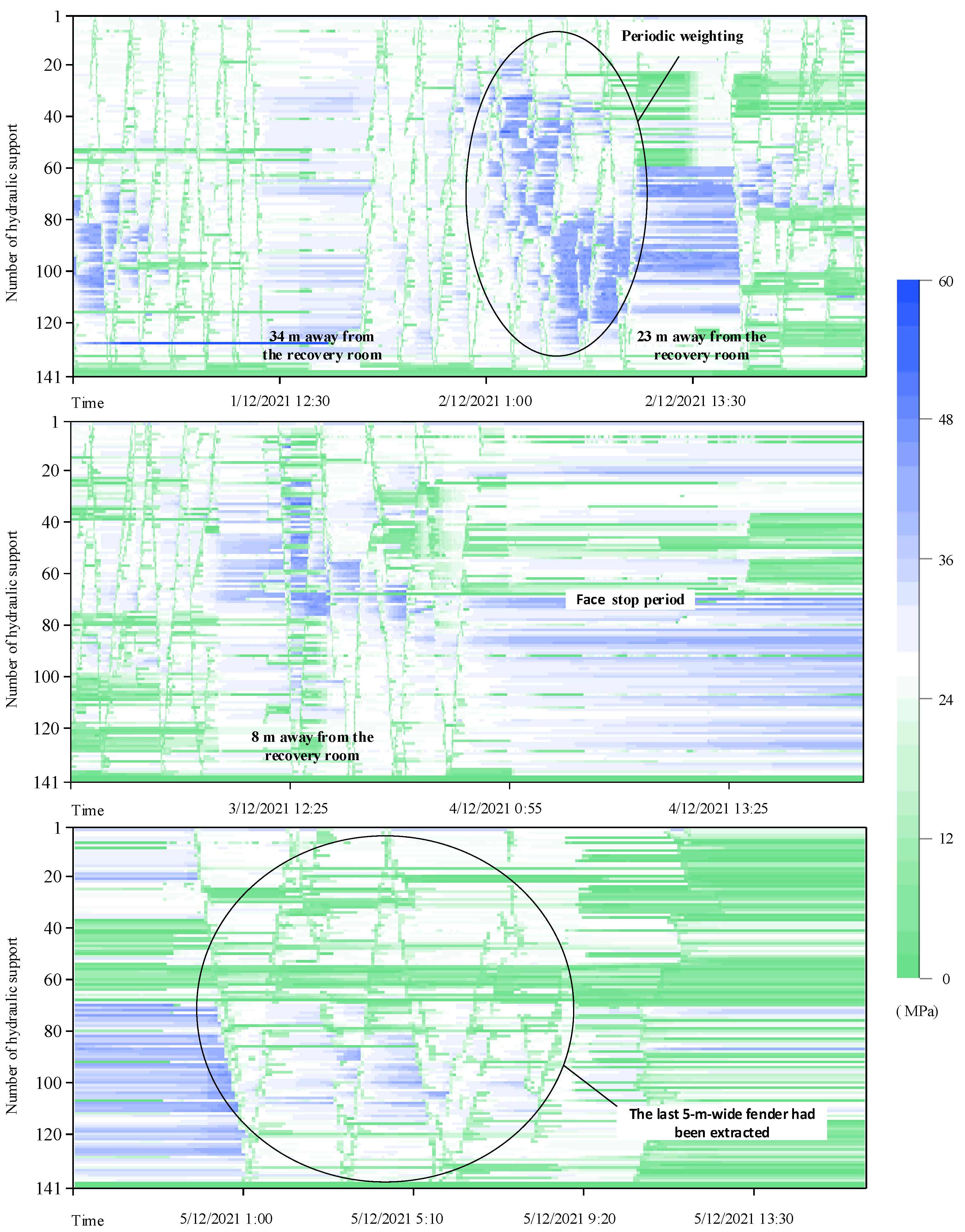
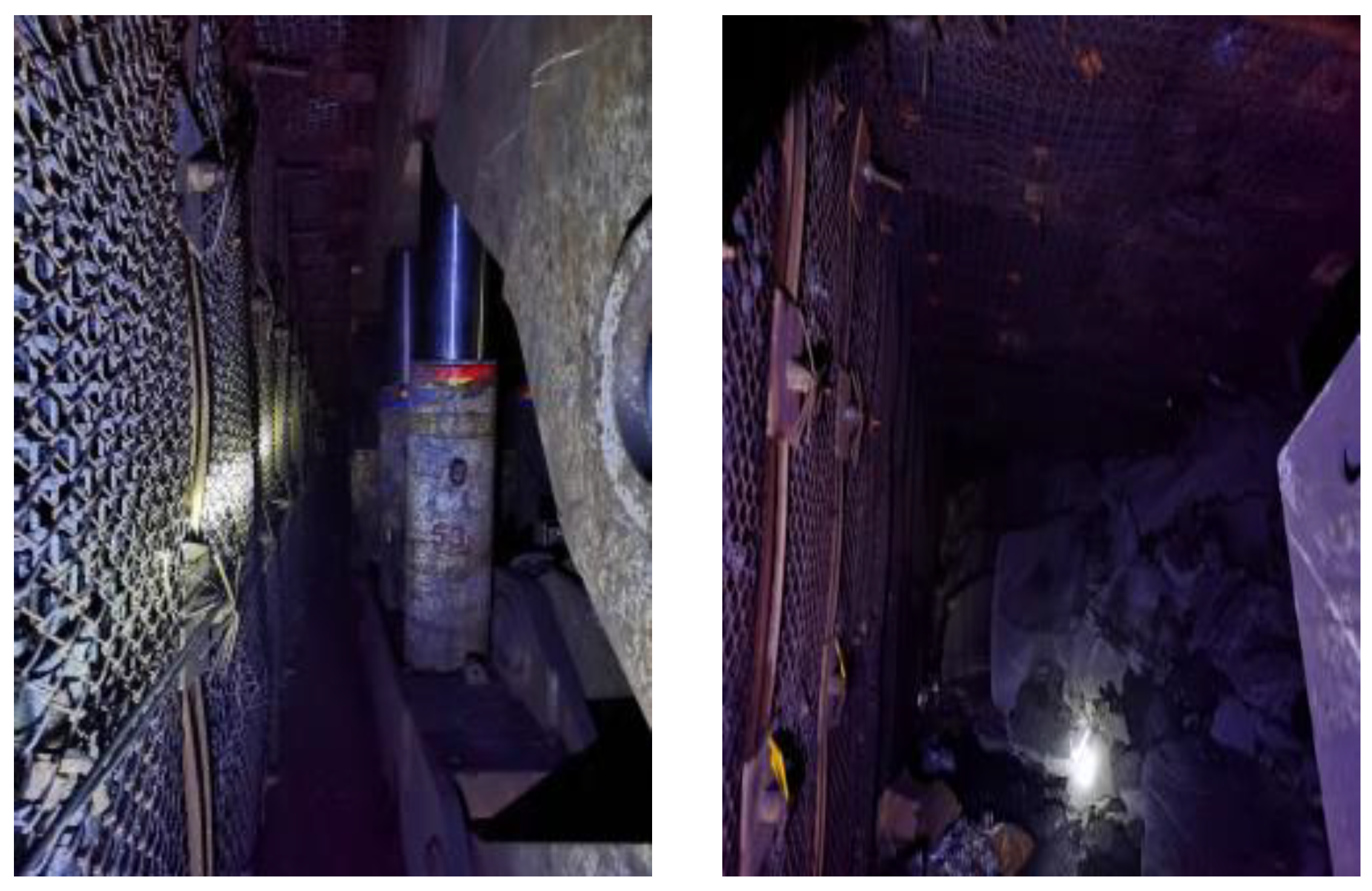
| In the normal direction Δσn = −knΔun Where Δσn and Δun are the effective normal stress increment and normal displacement increment, respectively, and kn is the normal stiffness of the contact. In the shear direction, if |τs| ≤ c + σn tanφ = τsmax then Δτs = −ksΔuse or else, if |τs| ≥ τsmax then τs = sign (Δus) τsmax where φ and c are the cohesion and friction angle of the contact, respectively. Δuse is the elastic component of the incremental shear displacement, and Δus is the total incremental shear displacement. a. Coulomb friction law [16,17] | 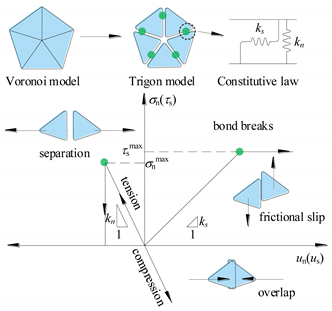 b. Micro-contacts yielding process in Trigon model [17,18] |
| Rock Strata | Intact Rock | Rock Quality Designation | Rock Mass | |||
|---|---|---|---|---|---|---|
| Er (GPa) | σc (MPa) | Em (GPa) | σcm (MPa) | σtm (MPa) | ||
| Coal | 2.12 | 9.66 | 58 | 0.31 | 2.89 | 0.29 |
| Mudstone | 3.53 | 23.49 | 72 | 0.95 | 10.26 | 1.03 |
| Siltstone | 4.06 | 26.72 | 81 | 1.60 | 14.88 | 1.49 |
| Fine-grained sandstone | 4.55 | 34.73 | 92 | 2.88 | 26.03 | 2.60 |
| Lithology | Matrix Properties | Contact Properties | |||||
|---|---|---|---|---|---|---|---|
| Density (kg·m−3) | E (GPa) | Kn (GPa/m) | Ks (GPa/m) | Cohesion (MPa) | Friction (°) | Tensile Strength (MPa) | |
| Coal | 1263 | 0.31 | 24.55 | 19.15 | 0.91 | 18 | 0.23 |
| Mudstone | 2182 | 0.95 | 76.72 | 59.84 | 3.27 | 20 | 1.00 |
| Limestone | 2267 | 1.60 | 129.21 | 100.78 | 4.38 | 20 | 1.40 |
| Fine-grained sandstone | 2358 | 2.88 | 243.00 | 189.54 | 7.30 | 23 | 2.50 |
| Lithology | Young’s Modulus (GPa) | UCS (MPa) | ||||
|---|---|---|---|---|---|---|
| Target | Calibrated | Error (%) | Target | Calibrated | Error (%) | |
| Coal | 0.31 | 0.317 | 2.26 | 2.89 | 3.04 | 5.19 |
| Mudstone | 0.95 | 0.916 | 3.58 | 10.26 | 10.40 | 1.36 |
| Siltstone | 1.60 | 1.592 | 0.50 | 14.88 | 14.20 | 4.57 |
| Fine-grained sandstone | 2.88 | 2.820 | 2.08 | 26.03 | 24.49 | 5.92 |
| Element | Property | Value |
|---|---|---|
| Cable | Elastic modulus | 200 GPa |
| Stiffness of the grout | 2 × 109 N/m2 | |
| Cohesive capacity of the grout | 4 × 105 N/m | |
| Beam | Elastic modulus | 200 GPa |
| Tensile yield strength | 500 MPa | |
| Compressive yield strength | 500 MPa | |
| Interface normal stiffness | 10 GPa/m | |
| Interface shear stiffness | 10 GPa/m | |
| Support | Maximum force at highest loading | 18,000 kN |
Disclaimer/Publisher’s Note: The statements, opinions and data contained in all publications are solely those of the individual author(s) and contributor(s) and not of MDPI and/or the editor(s). MDPI and/or the editor(s) disclaim responsibility for any injury to people or property resulting from any ideas, methods, instructions or products referred to in the content. |
© 2023 by the authors. Licensee MDPI, Basel, Switzerland. This article is an open access article distributed under the terms and conditions of the Creative Commons Attribution (CC BY) license (https://creativecommons.org/licenses/by/4.0/).
Share and Cite
Li, G.; Wang, X.; Bai, J.; Zhang, Y.; Zhang, F.; Li, M. Weighting Failure Mechanisms of Pre-Driven Recovery Rooms and Evaluation of Hydraulic Fracturing Applications: A Case Study. Appl. Sci. 2023, 13, 5116. https://doi.org/10.3390/app13085116
Li G, Wang X, Bai J, Zhang Y, Zhang F, Li M. Weighting Failure Mechanisms of Pre-Driven Recovery Rooms and Evaluation of Hydraulic Fracturing Applications: A Case Study. Applied Sciences. 2023; 13(8):5116. https://doi.org/10.3390/app13085116
Chicago/Turabian StyleLi, Guanjun, Xiangyu Wang, Jianbiao Bai, Yongqiang Zhang, Feiteng Zhang, and Menglong Li. 2023. "Weighting Failure Mechanisms of Pre-Driven Recovery Rooms and Evaluation of Hydraulic Fracturing Applications: A Case Study" Applied Sciences 13, no. 8: 5116. https://doi.org/10.3390/app13085116




